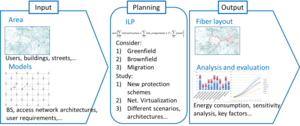Optimized network planning for converged optical access networks
| Funding Agency: | DFG |
| Duration: | 3 years, 01.01.2016 - 31.12.2018 |
| Contact: | E. Grigoreva (e.grigoreva@tum.de) |
| C. Mas Machuca (cmas@tum.de) | |
| W. Kellerer (wolfgang.kellerer@tum.de) |
Scope of Project
This research project aims at modelling, investigating, implementing and evaluating new planning methods for future converged access networks. These new methods consider critical design parameters of the different technologies (e.g., capacity, transmission distance, fan out), targeted area characteristics (e.g., existing infrastructure, optical network unit expected locations, requested bandwidth and reliability per location) as well as parameters for optimization (e.g., performance, efficiency, power consumption). The operational processes of heterogeneous access networks have to be remodeled, implemented and evaluated. Since network virtualization provides the basis for new business models for infrastructure sharing, optimal mapping of virtual network provider requests into converged access networks have to be included in the developed planning method.

Contributions
- Abstract topologies for strategic network planning: In this project, the Gabriel Graph (GG) and the proposed Procedural Topology Generation (PTG) have been implemented, analyzed and compared against the analysis results on a real geography map, i.e., Open Street Maps (OSM). The abstract topologies have been evaluated based on the graph and the planning evaluation results for different area types (rural, urban, and dense urban), and for different demands and architectures (Point-to-Point (P2P) for the MBSs and one-stage Gigabit Passive Optical Network (GPON) for the residential users). Based on the evaluation and analysis, recommendations for operators on the use of the models have been given.
- Automated fixed network planning tool: a geography-based fixed network planning tool has been developed and published (publicly available at FixedNetworkPlanning). It is based on the ESRI ArcGIS and the heuristic methodology from Shahid and Mas Machuca. The tool provides the input for the analysis of all the planning-based case studies. It can be used to calculate the fiber and duct lengths for the abstract topologies evaluation, migrations model input, converged planning and comparison heuristics for the optimization formulations. The tool can be extended, and modified according to the planning needs. Making a publicly available tool guarantees that the results are reliable and reproducible.
- Converged optical network migrations model: Rational Agent based Decision Algorithm model has been developed and evaluated for residential and converged demand case. It takes into account user adoption uncertainty, as some users that have joined earlier can leave the network. The main contribution of the migration algorithm is the identification of the final migration step based on the maximized Net Present Value (NPV) or profitability of the project. In the current state-of-the-art, the migration state is normally considered to be fixed, e.g., Romero Reyes et al.. Finally, the assumptions of the problem have been evaluated in a sensitivity analysis of the important model parameters. The results have been summarized at JOCN.
- Network planning heuristics for the energy consumption minimization: Our contribution shows the adaptation of the network planning heuristics to minimize the energy consumption of the active components, while satisfying the user requirements. The results have been presented at ECOC and ICTON. Furthermore, the project proposed techniques to decrease energy consumption of protected access optical networks. The proposed protection scheme based on reflective monitoring has been presented in JLT and ICC. The work on the enhancement of survivability and power savings of optical networks have been presented in JOCN1, JOCN2 .
- Performance evaluation of wireless wake-ups: The energy savings in PONs have been defined by sleeping and doozing (ITU-T "Means and impact of GPON power savign), which means that the equipment has to be waken-up. We provide, a measurement based proof-of-concept that the waking-up of the equipment can be done though the public mobile networks if the delay requirements are not stringent.
- Converged network planning optimization models: Mixed Integer Program (MIPs) formulations, results and comparison for the separate and joint planning have been provided.as well as the benchmark for the heuristic separate and converged network planning. A further contribution of this part is an investigation of replacing the microwave-based mobile backhaul with the fiber.
- Heterogeneous Radio Access Network (RAN) protection: A proof-of-concept of the wireless protection options for the heterogeneous RAN has been presented in VNC. In our implementation case study on a RAN containing TETRA, LTE and WLAN, we have measured the packet loss rates, defined the empirical availability metric and analyzed with the RBDs. Here, we have showed based on the Dynamic Link Exchange Protocol (DLEP) tests bed that the ultra-reliable levels of availability are achievable in the RAN.
Additional Resources
- Geoprocessing software: ArcGIS
- Maps in open access: OpenStreetMaps
- Automated fixed network planning tool: